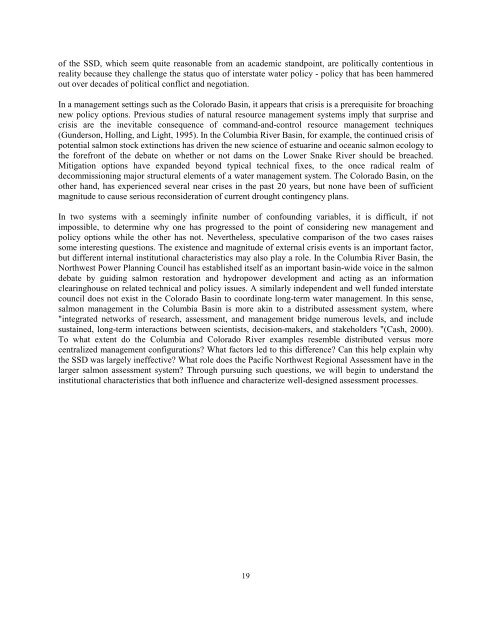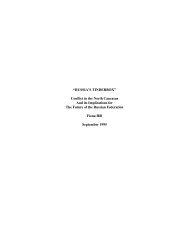Global Environmental Assessment Project - Belfer Center for ...
Global Environmental Assessment Project - Belfer Center for ...
Global Environmental Assessment Project - Belfer Center for ...
You also want an ePaper? Increase the reach of your titles
YUMPU automatically turns print PDFs into web optimized ePapers that Google loves.
of the SSD, which seem quite reasonable from an academic standpoint, are politically contentious in<br />
reality because they challenge the status quo of interstate water policy - policy that has been hammered<br />
out over decades of political conflict and negotiation.<br />
In a management settings such as the Colorado Basin, it appears that crisis is a prerequisite <strong>for</strong> broaching<br />
new policy options. Previous studies of natural resource management systems imply that surprise and<br />
crisis are the inevitable consequence of command-and-control resource management techniques<br />
(Gunderson, Holling, and Light, 1995). In the Columbia River Basin, <strong>for</strong> example, the continued crisis of<br />
potential salmon stock extinctions has driven the new science of estuarine and oceanic salmon ecology to<br />
the <strong>for</strong>efront of the debate on whether or not dams on the Lower Snake River should be breached.<br />
Mitigation options have expanded beyond typical technical fixes, to the once radical realm of<br />
decommissioning major structural elements of a water management system. The Colorado Basin, on the<br />
other hand, has experienced several near crises in the past 20 years, but none have been of sufficient<br />
magnitude to cause serious reconsideration of current drought contingency plans.<br />
In two systems with a seemingly infinite number of confounding variables, it is difficult, if not<br />
impossible, to determine why one has progressed to the point of considering new management and<br />
policy options while the other has not. Nevertheless, speculative comparison of the two cases raises<br />
some interesting questions. The existence and magnitude of external crisis events is an important factor,<br />
but different internal institutional characteristics may also play a role. In the Columbia River Basin, the<br />
Northwest Power Planning Council has established itself as an important basin-wide voice in the salmon<br />
debate by guiding salmon restoration and hydropower development and acting as an in<strong>for</strong>mation<br />
clearinghouse on related technical and policy issues. A similarly independent and well funded interstate<br />
council does not exist in the Colorado Basin to coordinate long-term water management. In this sense,<br />
salmon management in the Columbia Basin is more akin to a distributed assessment system, where<br />
"integrated networks of research, assessment, and management bridge numerous levels, and include<br />
sustained, long-term interactions between scientists, decision-makers, and stakeholders "(Cash, 2000).<br />
To what extent do the Columbia and Colorado River examples resemble distributed versus more<br />
centralized management configurations? What factors led to this difference? Can this help explain why<br />
the SSD was largely ineffective? What role does the Pacific Northwest Regional <strong>Assessment</strong> have in the<br />
larger salmon assessment system? Through pursuing such questions, we will begin to understand the<br />
institutional characteristics that both influence and characterize well-designed assessment processes.<br />
19
















